Anabolism and catabolism, as you can learn from the course in molecular biology, these are 2 phases of intermediate metabolism. The processes are closely interrelated and necessary to maintain vital functions.
Record content:
-
1 The concept of metabolism in biology
- 1.1 What is anabolism
- 1.2 What is catabolism
- 2 The relationship between anabolism and catabolism
- 3 The essence of the catabolism process
- 4 Physiology
-
5 Stages
- 5.1 First stage
- 5.2 Second phase
- 5.3 Stage Three
- 6 Signs of a catabolic state
-
7 How to slow down or avoid catabolism?
- 7.1 Foods to slow down catabolism
- 7.2 Training rules to slow down the process
- 7.3 Vitamin C
- 8 Video about catabolism
The concept of metabolism in biology
Metabolism means the absorption, transport and chemical transformation of substances in the body, as well as the release of metabolic end products into the environment.
Metabolism works as follows: nutrients are consumed depending on the needs of the body, and products are created that the human body cannot use further.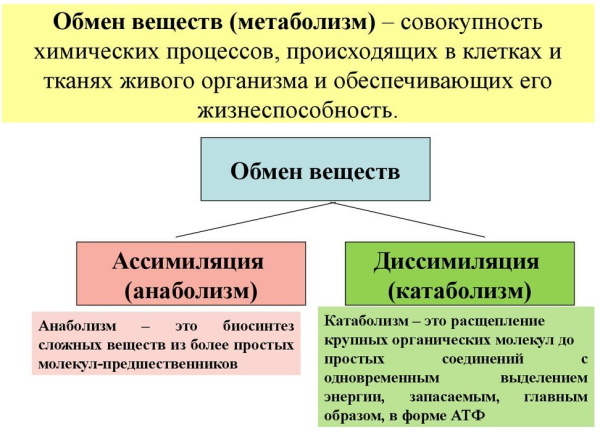
Then these substances are excreted through:
- breath;
- urine;
- feces;
- sweat.
As a heterotropic living being, humans must receive nutrients from the outside. They cannot take care of themselves, like plants, through photosynthesis.
Metabolic processes are complex chains of biochemical reactions that either produce energy-rich substances for storage or break them down for energy. Thus, there is a balance between the accumulation and decay of biomass, which adapts to the current needs of the body.
Catabolism is a process of metabolic decay in biology, therefore, its main principle is reaction cycles, that is, chains of reactions that go in a circle (for example, the citric acid cycle). Adenosine triphosphate (ATP) is a central molecule in metabolism. It is the main currency of the body's energy. ATP is involved as an energy source in almost all metabolic processes.
Hormones play a crucial role in regulating metabolism. This becomes especially evident in the course of diseases in which the production of hormones is either increased or decreased.
Metabolism is structured in such a way that some metabolic pathways either have a specific molecule as an end product or start with that molecule.
These so-called intermediates (e.g. acetyl-CoA) are intermediate stations, from which, depending on the current situation (catabolic or anabolic), the necessary paths. The metabolic process is divided into 2 stages: anabolic and catabolic.
What is anabolism
In the process of anabolism, complex molecules are synthesized on the basis of simple ones, and this is accompanied by a large expenditure of energy. All biomass accumulates after eating. Based on simple molecular structures, more complex substances are synthesized. Food energy is stored in the most compressed form possible. For example, fat and glycogen accumulate. Insulin is a classic anabolic hormone.
What is catabolism
Catabolism is (in biology, separation pathways are described) a metabolic process in which biomass is broken down. Complex molecules are broken down into simpler ones.
The purpose of these processes is to release energy stored in biomass (such as fat or glycogen). This leads to catabolic situations during hunger or exercise. Glucagon and adrenaline are hormones with strong catabolic effects
The relationship between anabolism and catabolism
The link between catabolism and anabolism occurs at 3 levels:
- At the carbon source level. Anabolic reactions, during which macromolecules are synthesized, occur with the help of substrates obtained from the products of catabolism.
- At the energy level. In the process of catabolism, energy is produced in the form of ATP.
- At the level of restorative ability. Catabolic processes are oxidative and donate high-energy electrons.
The essence of the catabolism process
Catabolism is the breakdown of metabolic products with the formation of low molecular weight compounds. Fats are broken down into fatty acids and glycerin, carbohydrates into sugars, and proteins into amino acids. This results in the release of high-energy compounds.
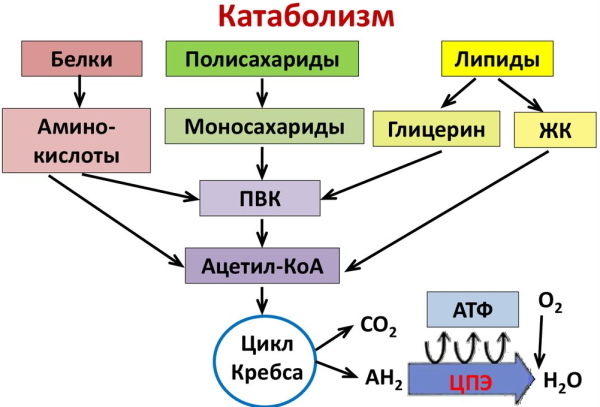
Molecular biology describes the breakdown of large molecules such as polysaccharides, lipids, nucleic acids and proteins, into smaller units such as monosaccharides, fatty acids, nucleotides and amino acids, respectively.
Catabolic processes are the opposite of anabolic processes. They are used to generate energy for anabolism, release small molecules for other purposes, detoxify chemicals, and regulate metabolic pathways.
Physiology
The transformation of food into cellular energy (in the form of ATP) occurs in 3 stages:
- Digestion of carbohydrates. The process begins in the mouth, where the glycosidic cleavage takes place, resulting in a mixture of dextrins, maltose and glucose. The α-amylase mixed with food remains active as food passes through the esophagus, but is rapidly inactivated in the acidic environment of the stomach. The main digestion site for carbohydrates is in the small intestine. The secretion of α-amylase in the small intestine converts any remaining starch molecules as well as dextrins to maltose. Then maltose is broken down by maltase into 2 glucose molecules. Disaccharides such as sucrose and lactose are not digested until they reach the small intestine, where sucrose and lactase act on them, respectively. The main products of complete hydrolysis of disaccharides and polysaccharides are 3 monosaccharide units: glucose, fructose and galactose. They are absorbed through the wall of the small intestine into the bloodstream.
- Digestion of proteins. It begins in the stomach, where the action of gastric juice hydrolyzes about 10% of the peptide bonds. Gastric juice is a mixture of water (over 99%), inorganic ions, hydrochloric acid, various enzymes and other proteins. The main digestive component of gastric juice is pepsinogen, an inactive enzyme produced by cells located in the stomach wall. When food enters the stomach after a fasting period, pepsinogen is converted to its active form, pepsin. The enzyme catalyzes the hydrolysis of peptide bonds within protein molecules. Protein digestion is completed in the small intestine. Pancreatic juice coming from the pancreas through the duct contains inactive enzymes such as trypsinogen and chymotrypsinogen. They are activated in the small intestine. Pancreatic juice also contains procarboxypeptidase, which is broken down by trypsin to carboxypeptidase. Amino acids released during protein digestion are absorbed through the intestinal wall into the circulatory system, where they can be used for protein synthesis during anabolism.
- Digestion of lipids. It begins at the top of the small intestine. A hormone secreted in this area stimulates the gallbladder to secrete bile into the duodenum. The main constituents of bile are bile salts, which emulsify large, water-insoluble lipid droplets. Another hormone promotes the secretion of pancreatic juice. Lipases in pancreatic juice catalyze the digestion of triglycerides, first to diglycerides, and then to 2 - monoglycerides and fatty acids. Monoglycerides and fatty acids pass through the intestinal mucosa into the bloodstream, where they are reintroduced synthesized into triglycerides and transported as lipoprotein complexes known as chylomicrons. Phospholipids and cholesterol esters undergo similar hydrolysis in the small intestine, and their constituent molecules are also absorbed through the intestinal mucosa.
Stages
Catabolism can be broken down into 3 main stages: digestion, energy release, energy storage. It is important to note that the catabolic pathways converge, merging at the third stage into the common pathway - the citric acid cycle.
First stage
In stage I, carbohydrates, fats and proteins are broken down into separate monomeric units: carbohydrates into simple sugars, fats into fatty acids and glycerin, and proteins into amino acids.
One of the parts of stage I of catabolism is called digestion - this is the breakdown of food molecules as a result hydrolysis reactions into individual monomeric units, which occurs in the mouth, stomach and thin intestines.
Second phase
In stage II, monomer units (or building blocks) are cleaved in different ways.
One of which produces ATP, with the formation of a general end product, which can then be used in stage III to produce even more ATP.
Stage Three
At this stage, the released energy is conserved. This process provides the chemical energy needed to maintain and grow cells.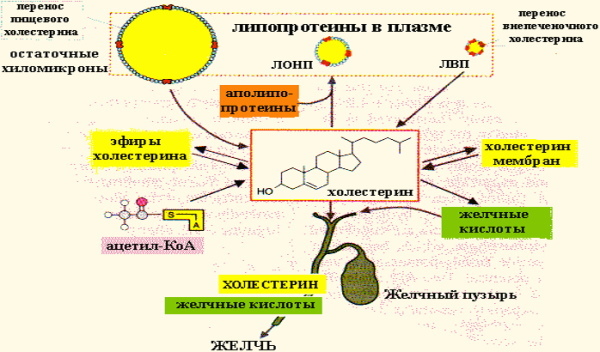
Some examples of catabolic processes include glycolysis, the citric acid cycle, and the breakdown of muscle protein to use amino acids in as substrates for gluconeogenesis, breakdown of fat in adipose tissue to fatty acids and oxidative deamination of neurotransmitters by monoamine oxidase.
Signs of a catabolic state
Catabolism is a designated process in biology that can temporarily be in equilibrium with anabolism or predominate over it. Catabolic states are caused by excessive training in the absence of proper nutrition, a decrease in the proportion of protein products in the diet.
The disorder leads to unwanted symptoms because it is closely related to the catabolic hormone cortisol:
- tiredness;
- joint and muscle pain;
- insomnia.
 Increased, intense training encourages increased adrenal cortisol production. The hormone replaces the loss of muscle tissue. Many people think that a few hours of training helped them build muscle, but in reality, the lost energy is compensated for by cortisol.
Increased, intense training encourages increased adrenal cortisol production. The hormone replaces the loss of muscle tissue. Many people think that a few hours of training helped them build muscle, but in reality, the lost energy is compensated for by cortisol.
This is the reason why the consumption of protein and carbohydrates plays an important role in building muscle mass. Overtraining will also weaken the body and the immune system, eventually leading to flu, colds and other illnesses.
Intense training requires a lot of protein and carbohydrates because a lot of muscle tissue is lost during strenuous training.
How to slow down or avoid catabolism?
There are some simple steps you can take to avoid a catabolic state. A protein drink can be beneficial after a few serious workouts.
Taking carbohydrates and proteins about 1–2 hours before and after your workout will help you feel energized.
A number of protein drinks have now been proven to help avoid a catabolic state. These drinks contain amino acids such as gamma-aminobutyric acid or GABA, which are responsible for the production of growth hormones or the restoration of muscle mass.
Foods to slow down catabolism
Catabolism - in biology, as a molecular science, it is sometimes described as a destructive process that destroys the body's energy store that was previously created. As a result, unpleasant symptoms may begin. The decrease in energy begins with glycogen stores.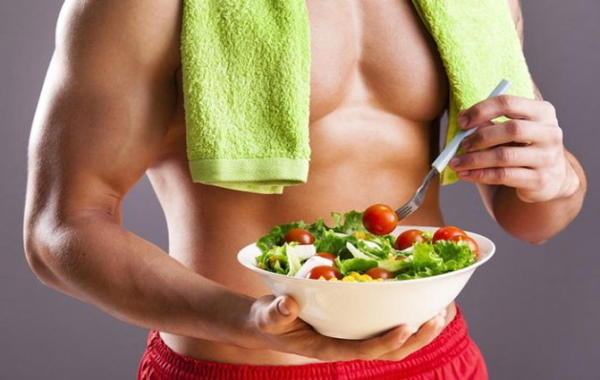
To prevent this from happening, you should pay attention to the following foods that do not bring health benefits:
| Fruit juice | Eating juices and other foods high in sugar can destroy the body and disrupt metabolism, including lethargy, food cravings, and inflammation. |
| Refined grain | Eating large amounts of refined grains can also affect metabolism and weight loss efforts. Many foods that appear to be "whole grains" and are therefore considered healthy can contribute many empty calories to the diet. Research shows that a high intake of refined grains is associated with an increased risk of heart disease as well as an inflammatory protein concentration. |
| Processed vegetable oils | Most commercially available vegetable oils are often combined with solvents such as hexane in the process. production, and it is not clear from the data whether there are long-term health risks associated with consuming these solvents. When used in processed foods, these oils can oxidize, leading to inflammation throughout the body, disrupting hormones and metabolism. |
| Artificial sweeteners | Aspartame and sucralose can stimulate appetite and increase carbohydrate cravings. "Saving" calories by eating foods sweetened with aspartame ultimately does not yield any savings due to increased appetite and therefore calorie intake. |
| Flavored yoghurts | Packed with sugars and dyes, these simple carbohydrates are digested quickly and hunger soon after. |
| Regular apples | There is now a certain type of fungicide that is used to treat fresh fruits and vegetables, resulting in weight gain. |
| Salt | Sodium chloride is found in a variety of foods. This increases blood flow, thereby placing additional stress on the kidneys. Disruption of the work of this organ leads to a slowdown in metabolism. |
Complex carbohydrates will help prevent muscle breakdown, and foods rich in "good cholesterol" activate anabolic processes.
Training rules to slow down the process
Recent research shows that variety of exercise slows down the destructive process. Combination of functional training (exercises that mimic the movements of daily activity), high-intensity interval training (alternating high-energy movement with active rest) and flexibility training is the best way to achieve muscle recovery masses.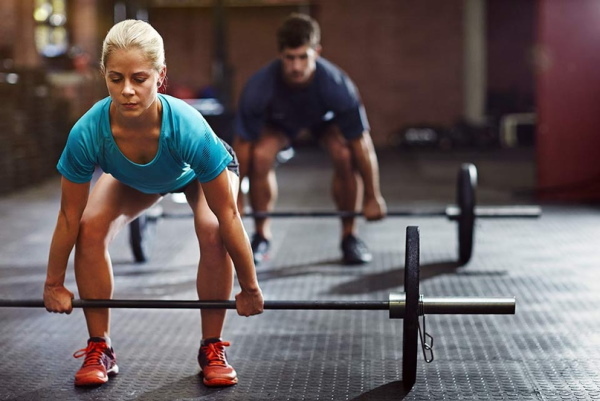
Stress training will help prevent muscle breakdown, which should be done no more than 1 time in 3 weeks.. A well-designed fitness regimen can affect health and well-being, and even play a bigger role than medications.
Vitamin C
Vitamin C is vital for strengthening the immune system and contributes significantly to maintaining the anabolic state. Vitamin C performs many functions: it acts as a coenzyme or as a cofactor in the body, helps the normal functioning of cellular units and subcellular structures.
In metabolism, the vitamin accepts and gives up hydrogen, plays an important role in the synthesis of neurotransmitters, compounds that ensure the transmission of nerve impulses between nerve axons.
In the biological structure of the body, anabolism and catabolism are essential for better functioning of the body. They are opposite, however, in the absence of any of them, the metabolism is disturbed, and the body stops working properly.
Video about catabolism
Catabolism and anabolism - the role of the process in the body:



